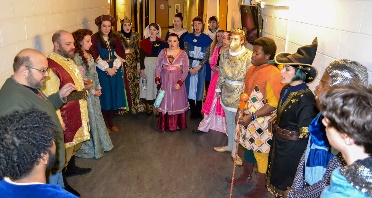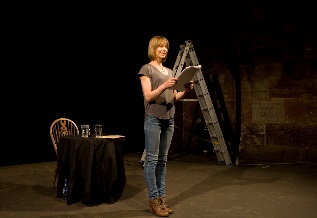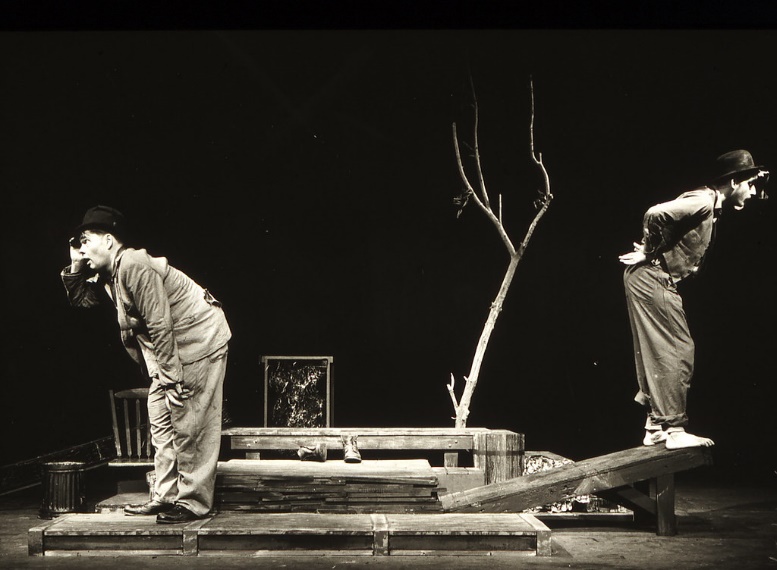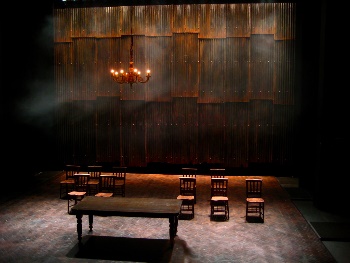4: Theatre Appreciation- A Student’s Perspective
- Page ID
- 187854
\( \newcommand{\vecs}[1]{\overset { \scriptstyle \rightharpoonup} {\mathbf{#1}} } \)
\( \newcommand{\vecd}[1]{\overset{-\!-\!\rightharpoonup}{\vphantom{a}\smash {#1}}} \)
\( \newcommand{\dsum}{\displaystyle\sum\limits} \)
\( \newcommand{\dint}{\displaystyle\int\limits} \)
\( \newcommand{\dlim}{\displaystyle\lim\limits} \)
\( \newcommand{\id}{\mathrm{id}}\) \( \newcommand{\Span}{\mathrm{span}}\)
( \newcommand{\kernel}{\mathrm{null}\,}\) \( \newcommand{\range}{\mathrm{range}\,}\)
\( \newcommand{\RealPart}{\mathrm{Re}}\) \( \newcommand{\ImaginaryPart}{\mathrm{Im}}\)
\( \newcommand{\Argument}{\mathrm{Arg}}\) \( \newcommand{\norm}[1]{\| #1 \|}\)
\( \newcommand{\inner}[2]{\langle #1, #2 \rangle}\)
\( \newcommand{\Span}{\mathrm{span}}\)
\( \newcommand{\id}{\mathrm{id}}\)
\( \newcommand{\Span}{\mathrm{span}}\)
\( \newcommand{\kernel}{\mathrm{null}\,}\)
\( \newcommand{\range}{\mathrm{range}\,}\)
\( \newcommand{\RealPart}{\mathrm{Re}}\)
\( \newcommand{\ImaginaryPart}{\mathrm{Im}}\)
\( \newcommand{\Argument}{\mathrm{Arg}}\)
\( \newcommand{\norm}[1]{\| #1 \|}\)
\( \newcommand{\inner}[2]{\langle #1, #2 \rangle}\)
\( \newcommand{\Span}{\mathrm{span}}\) \( \newcommand{\AA}{\unicode[.8,0]{x212B}}\)
\( \newcommand{\vectorA}[1]{\vec{#1}} % arrow\)
\( \newcommand{\vectorAt}[1]{\vec{\text{#1}}} % arrow\)
\( \newcommand{\vectorB}[1]{\overset { \scriptstyle \rightharpoonup} {\mathbf{#1}} } \)
\( \newcommand{\vectorC}[1]{\textbf{#1}} \)
\( \newcommand{\vectorD}[1]{\overrightarrow{#1}} \)
\( \newcommand{\vectorDt}[1]{\overrightarrow{\text{#1}}} \)
\( \newcommand{\vectE}[1]{\overset{-\!-\!\rightharpoonup}{\vphantom{a}\smash{\mathbf {#1}}}} \)
\( \newcommand{\vecs}[1]{\overset { \scriptstyle \rightharpoonup} {\mathbf{#1}} } \)
\( \newcommand{\vecd}[1]{\overset{-\!-\!\rightharpoonup}{\vphantom{a}\smash {#1}}} \)
\(\newcommand{\avec}{\mathbf a}\) \(\newcommand{\bvec}{\mathbf b}\) \(\newcommand{\cvec}{\mathbf c}\) \(\newcommand{\dvec}{\mathbf d}\) \(\newcommand{\dtil}{\widetilde{\mathbf d}}\) \(\newcommand{\evec}{\mathbf e}\) \(\newcommand{\fvec}{\mathbf f}\) \(\newcommand{\nvec}{\mathbf n}\) \(\newcommand{\pvec}{\mathbf p}\) \(\newcommand{\qvec}{\mathbf q}\) \(\newcommand{\svec}{\mathbf s}\) \(\newcommand{\tvec}{\mathbf t}\) \(\newcommand{\uvec}{\mathbf u}\) \(\newcommand{\vvec}{\mathbf v}\) \(\newcommand{\wvec}{\mathbf w}\) \(\newcommand{\xvec}{\mathbf x}\) \(\newcommand{\yvec}{\mathbf y}\) \(\newcommand{\zvec}{\mathbf z}\) \(\newcommand{\rvec}{\mathbf r}\) \(\newcommand{\mvec}{\mathbf m}\) \(\newcommand{\zerovec}{\mathbf 0}\) \(\newcommand{\onevec}{\mathbf 1}\) \(\newcommand{\real}{\mathbb R}\) \(\newcommand{\twovec}[2]{\left[\begin{array}{r}#1 \\ #2 \end{array}\right]}\) \(\newcommand{\ctwovec}[2]{\left[\begin{array}{c}#1 \\ #2 \end{array}\right]}\) \(\newcommand{\threevec}[3]{\left[\begin{array}{r}#1 \\ #2 \\ #3 \end{array}\right]}\) \(\newcommand{\cthreevec}[3]{\left[\begin{array}{c}#1 \\ #2 \\ #3 \end{array}\right]}\) \(\newcommand{\fourvec}[4]{\left[\begin{array}{r}#1 \\ #2 \\ #3 \\ #4 \end{array}\right]}\) \(\newcommand{\cfourvec}[4]{\left[\begin{array}{c}#1 \\ #2 \\ #3 \\ #4 \end{array}\right]}\) \(\newcommand{\fivevec}[5]{\left[\begin{array}{r}#1 \\ #2 \\ #3 \\ #4 \\ #5 \\ \end{array}\right]}\) \(\newcommand{\cfivevec}[5]{\left[\begin{array}{c}#1 \\ #2 \\ #3 \\ #4 \\ #5 \\ \end{array}\right]}\) \(\newcommand{\mattwo}[4]{\left[\begin{array}{rr}#1 \amp #2 \\ #3 \amp #4 \\ \end{array}\right]}\) \(\newcommand{\laspan}[1]{\text{Span}\{#1\}}\) \(\newcommand{\bcal}{\cal B}\) \(\newcommand{\ccal}{\cal C}\) \(\newcommand{\scal}{\cal S}\) \(\newcommand{\wcal}{\cal W}\) \(\newcommand{\ecal}{\cal E}\) \(\newcommand{\coords}[2]{\left\{#1\right\}_{#2}}\) \(\newcommand{\gray}[1]{\color{gray}{#1}}\) \(\newcommand{\lgray}[1]{\color{lightgray}{#1}}\) \(\newcommand{\rank}{\operatorname{rank}}\) \(\newcommand{\row}{\text{Row}}\) \(\newcommand{\col}{\text{Col}}\) \(\renewcommand{\row}{\text{Row}}\) \(\newcommand{\nul}{\text{Nul}}\) \(\newcommand{\var}{\text{Var}}\) \(\newcommand{\corr}{\text{corr}}\) \(\newcommand{\len}[1]{\left|#1\right|}\) \(\newcommand{\bbar}{\overline{\bvec}}\) \(\newcommand{\bhat}{\widehat{\bvec}}\) \(\newcommand{\bperp}{\bvec^\perp}\) \(\newcommand{\xhat}{\widehat{\xvec}}\) \(\newcommand{\vhat}{\widehat{\vvec}}\) \(\newcommand{\uhat}{\widehat{\uvec}}\) \(\newcommand{\what}{\widehat{\wvec}}\) \(\newcommand{\Sighat}{\widehat{\Sigma}}\) \(\newcommand{\lt}{<}\) \(\newcommand{\gt}{>}\) \(\newcommand{\amp}{&}\) \(\definecolor{fillinmathshade}{gray}{0.9}\)Now that you have made it to the end of this textbook, pausing to reflect on the torrent of theatrical knowledge you have consumed is understandably overwhelming. As I have read through these chapters myself, I’ve found it helpful to focus on specific points made by each author that has resonated with me for one reason or another and consider how they influence the way I appreciate the art of theatre. Theatre Appreciation is accurately labeled a “survey” course, as it is designed to give an overview of the incredibly dense history and vast inner workings of the theatrical arts, which is no minor task. Believe these authors when they tell you that one chapter is not nearly enough time to adequately cover their respective subjects. So, don’t feel pressured to suddenly be struck with the desire for continued research into each of these subjects. Of course, this may be ideal in the eyes of your professors, and even some of your classmates might fall into this category; but if you do not, we hope there was at least one valuable aspect you can take away from this class. As a theatre student who has previously completed this course, I can say with certainty that I didn’t feel the urge to study every single topic more in-depth. But what mattered is that I resonated with enough content to spark a change in how I perceived theatre. My more casual view of theatre as an extracurricular, or a choice to fill my liberal arts credit, was altered to view theatre as an actual career path—don’t get me wrong, if you’ve found yourself here to fill a credit, we’ve loved having you and hope you stick around!

Working professionally in the theatre, whether in the realm of writing, designing, or performing is intimidating. The lack of promised financial gratification and stability cause many to abandon their pursuit of a career in the industry, but that does not mean it is not a valid option for a successful career. Look back on interviews with theatre professionals like TJ Young, Alaine Aldaffer, Shawn Irish, and Hal Luftig, and know that they found success by doing what they love. Each of them was able to find their place within the theatre and utilize their skills and talents to their fullest potential. In my time studying theatre, my own definition of “success” has been altered. Previously, “success” has always correlated to the amount of money in my bank account, but from what these authors have written, to be successful in the industry of theatre is to succeed in telling your story effectively to an audience. As I continue my own attempt to forge a theatrical career, I can wholeheartedly confess that the intimidation factor is still extremely present; but continuing to learn about the facets of the current industry, how it functions, and the history behind its development has made it considerably less daunting. Gaining new artists in the theatre industry is what keeps it ever-growing and ever-evolving, so if you feel the urge to learn more, have confidence that you started in the right place.
What makes theatre such a powerful and long-lasting art form is that despite differences in location, time period, genre, or level of experience, it grounds itself in a universal concept. The purpose for which each playwright crafts their story may differ, but all purposes are achieved through the same means—telling stories to an audience. After reading through the different chapters of this textbook, you can connect them together with the throughline of dedication to telling a story. I urge you to take all the clichés with a grain of salt, because despite how generic it sounds, it is inherent in our existence as human beings. As you have learned by reading the chapter on acting, human beings naturally have the remarkable ability of impersonation and mimicry. Alongside this is the natural instinct to mirror other humans. When we tell these stories, our audience will subconsciously mirror the person or people performing, making storytelling through live performance so powerful. It has an instinctual and unavoidable effect on emotions and theatre artists harness this effect to guide the audience’s collective response in harmony with the playwright’s purpose and the story’s function.
In all honesty, I find that the amount of storytelling present in our everyday lives is grossly underestimated. It truly is unavoidable. Out of habit we tell our roommates about our day as a form of bonding, we complain to our friends about the customer in front of us in at the coffee shop, and we calculate the best way to tell our friends about how “crazy” our Spring Break was (and make them believe it). There is a perpetual awareness of how we tell stories to achieve an intended reaction or result from our listeners. Obviously, playwrights, directors, designers, and actors, study technical elements of storytelling specific to the medium of theatre, but in its most basic form, we all understand how to do it.
We enjoy hearing them, watching them on screen, or reading them on a page, so why not venture into the theatre to enjoy it in a different setting? There are limitless possibilities at your disposal when deciding how you will experience live theatre. You might find yourself in a found space, where the boundary between actors and audience is fluid, or even play the role of “spect-actor” in a project under the umbrella of the Theatre of the Oppressed, gifted the ability to provide commentary on a social issue; or travel to see a Chinese Peking Opera adorned in all of its acrobatics and effervescence; or even landing on Broadway in New York City to see a classic musical, filled with soaring vocals and wonderous theatricality. Wherever you do end up, be sure to take notice of how you feel after the curtain falls. Were you collecting yourself from being moved to tears by a tragic performance? Or giddy from sitting through a side-splitting comedy? Either way, you have suffered a change in your person simply by seeing a performance. It is learning to appreciate the effect theatre has on you that begins your appreciation of theatre in its entirety.
The immediacy of theatre’s effects on an audience member is part of its power. When the show begins, the audience must willingly suspend their disbelief and temporarily be brought out of their world and placed into the one on the stage. As Aristotle claimed, seeing a good play should provoke a sense of catharsis, that allows us to safely experience emotions in a removed manner. We experience empathy towards these characters as we grieve for them, hope for them, rage for them, all as we invest ourselves in watching the actors on stage. However, as much as this is an essential convention of theatre, it can also be broken to achieve a purpose. There may be a time when you witness a play in which the playwright takes specific measures to remind the audience that they are simply that: people in a theatre watching actors on a stage. Yet, we are still somehow changed after the fact. Knowing that we are in a fictional, constructed world inhabited by fictional characters does not take away from the collective experience endured by the audience.
Allowing yourself to be receptive to the influence of theatre can be an amazing thing. Every story has a message, or indefinite messages, that spawn from the different interpretations of each person. “Given circumstances” can be used to describe the concrete details of the beginning of a play or scene, but it also describes the state of the audience that enters the theatre. Many people in the theatre refer to the audience as its own character, after all. In every single performance, the audience is comprised of different people with different life experiences. Think back to the “Applied Theatre” chapter, which focuses on theatre that is directed towards a specific group of people with a determined given circumstance, created with the intention of evoking change and bringing attention to issues that affect that group. Think about what was said about Prison Theatre; the example given about a production of Waiting for Godot performed by and for incarcerated people shows how a very specific set of given circumstances affects the audience’s reaction to the performance. Or how Reminiscence Theatre is devised from the memories of the elderly. Even if you fall outside of the targeted group of such productions, everyone resonates with different elements of the story, even the seemingly insignificant.


When considering the path of theatre both academically and professionally, know that it is not a field that suits only one “type” of person. If you can’t envision yourself as the playwright who composes the story and structure for a production, perhaps you gravitate more towards a position that brings the play to life on stage. Regardless of where you are drawn to, don’t shy away from taking advantage of your preexisting skills or unrelated talents and expertise to assist you (there’s a reason an actor’s resumé has a section dedicated to “special skills”). Something like having visual knowledge and appreciation of art is valuable because the end result of any performance is the presentation for an audience in a physical space. Even when simply reading a script, remember that it was written with the intention of taking on a physical form, it’s just in need of the collaborative effort of other artists to forge it into reality. Designers, directors, and even actors must have an awareness of visual composition and how crafting what the audience sees serves the story.
The phrase, “Serve the story,” or a variation of the same expression, is often heard in the theatre. If all artists working on a show set this as a goal, it creates a unified world able to support the actors who tell the story. For example, the design of the set must consider the basic needs of entrances, exits, and other specified elements, but must also work to construct the less tangible element of the feeling or atmosphere of the play’s world. Our chapter on scenic design even elaborates on the script analysis done by the set designer, in order to effectively immerse the audience in the world of the story and develop a deeper understanding of the characters who live in that world. This is aided by the lighting design that not only ensures actors are visible, but directs our focus, and creates different moods.

As with any discipline or profession, efficient collaboration is an essential part of success. In Chapter 5, “The Director,” we are introduced to the concept of production meetings and how vital they are to the creation of a show that exists in a unified world. Also within this chapter, we learn that directors often do not start out as directors, but find themselves there after working in different areas of theatre. I think this applies to other niches of the theatre world as well, which might seem encouraging to students wanting to work in the art form. You may intend to become a lighting designer and end up a specialist in the properties department, or an actor may decide that the stage-management scene is where they thrive. But on your journey, gain experience with whatever you can. Since the director is responsible for deciding the entire creative interpretation of the production, it helps to grasp what is actually achievable in each department as they add in their respective elements. Though directors are not the only people who should have a well-rounded range of skills. Well-roundedness is imperative to building confidence while working in the theatre in any occupation. In the same way, learning to appreciate all kinds of theatre outside your familiar conventions provides a sturdy foundation for a well-rounded theatre student.
Well-roundedness in skillset must be accompanied by well-roundedness in cultural knowledge and appreciation. “Theatre Appreciation,” reaches across the globe and teaches us to appreciate types of theatre that we might have never known existed. Artists tend to be influenced by styles from previous time periods or different locations, but a true appreciation of the art requires an appreciation of the culture it was formed in. Theatre has evolved because of the interactions between cultural groups, but as we continue to learn about its history, we must remember the dominance of western culture in how we perceive theatre. In Chapter 14, “Global Theatre,” author Missy Maramara states:
The history of theater often focuses on the Western development of the art form and tends to exclude forms that do not share the same formal elements as outlined by Ancient Greek philosopher, Aristotle. This can be attributed to the tendency of historical accounts to focus on the different movements of power within the Western Hemisphere: from the Greeks to the Romans, to the Europeans, such as France, Germany, England, and Spain, and to Russia and the United States of America. History of theatre follows mainstream historical accounts of accomplishments in the arts as a reflection of a world power. In other words, history is told from the perspective of the global leader and highlights the accomplishments of its global power.
It is only when we acknowledge this aspect of the history of theatre and know how it affects the development of theatre in the present day, that we can begin to expand our view to appreciate other cultural traditions in the art form. Learning about different cultures is not only important in gaining knowledge about theatre history but it is also built into the process of putting on a production. Designers of shows that occur in a specific time and place must conduct research about the visual elements that are characteristic of that time and place. If the director is taking on a piece that either exists in a culture outside of their own, or addresses issues or experiences that they have not dealt with firsthand, again, they must research those elements in order to be successful. You need to make sure that you understand the story being told and know how to work with the story to tell it in the most effective way. In the same way, actors must also do research because they themselves are the ones telling the story for each audience.
Learning about the process of becoming and working as an actor can be beneficial to anyone, regardless of occupation. If there is any group of people that must practice persistence and determination, it is actors. If you remember reading the interview with casting director, Alaine Aldaffer, she concluded with quite a startling statistic: that only about 8% of actors make a living by acting. Actors pursue this career fully knowing its incredibly competitive nature, but it is their love of the craft that motivates them. What is most notable to me about that interview, however, is her statement that the best actor often does not get the part. You could be the most experienced, technically perfect, and impressive actor, but if you are not quite a fit for the character and world of the play envisioned by the director, you won’t get cast. The point I am intending to be taken away from this is that there is an understanding of serving the story. An actor needs to understand that they are not the best choice to best serve the playwright’s story and continue to audition until they find where they can do that. Obviously, things like experience and training matter in becoming an actor, but it is the ability to take criticism and use it towards improving your craft that anyone can apply to their own occupation.
Appreciating Theatre is not only for those pursuing a career in the industry, but can be utilized by all as we gain a more fully realized knowledge of an art form rooted in human behavior and connection. What we learn by studying theatre can be applied to a vast number of other subjects and provide valuable skills to use throughout our lives. To appreciate theatre is to appreciate stories, art, and culture, that has a message, and letting yourself be changed by the experience.

